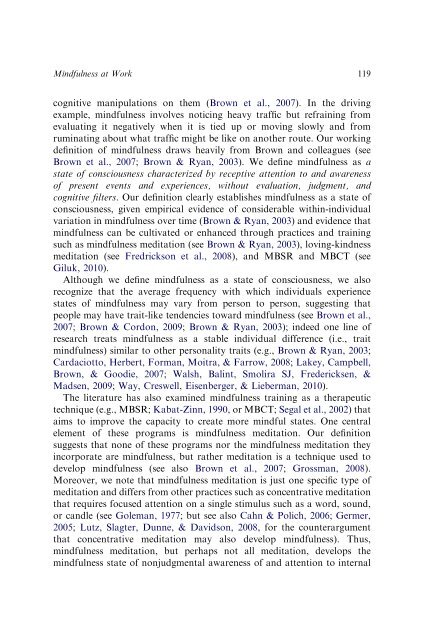Mindfulness at work (Glomb, Duffy et al, 2012) - Human Resources
Mindfulness at work (Glomb, Duffy et al, 2012) - Human Resources
Mindfulness at work (Glomb, Duffy et al, 2012) - Human Resources
Create successful ePaper yourself
Turn your PDF publications into a flip-book with our unique Google optimized e-Paper software.
<strong>Mindfulness</strong> <strong>at</strong> Work 119cognitive manipul<strong>at</strong>ions on them (Brown <strong>et</strong> <strong>al</strong>., 2007). In the drivingexample, mindfulness involves noticing heavy traffic but refraining fromev<strong>al</strong>u<strong>at</strong>ing it neg<strong>at</strong>ively when it is tied up or moving slowly and fromrumin<strong>at</strong>ing about wh<strong>at</strong> traffic might be like on another route. Our <strong>work</strong>ingdefinition of mindfulness draws heavily from Brown and colleagues (seeBrown <strong>et</strong> <strong>al</strong>., 2007; Brown & Ryan, 2003). We define mindfulness as ast<strong>at</strong>e of consciousness characterized by receptive <strong>at</strong>tention to and awarenessof present events and experiences, without ev<strong>al</strong>u<strong>at</strong>ion, judgment, andcognitive filters. Our definition clearly establishes mindfulness as a st<strong>at</strong>e ofconsciousness, given empiric<strong>al</strong> evidence of considerable within-individu<strong>al</strong>vari<strong>at</strong>ion in mindfulness over time (Brown & Ryan, 2003) and evidence th<strong>at</strong>mindfulness can be cultiv<strong>at</strong>ed or enhanced through practices and trainingsuch as mindfulness medit<strong>at</strong>ion (see Brown & Ryan, 2003), loving-kindnessmedit<strong>at</strong>ion (see Fredrickson <strong>et</strong> <strong>al</strong>., 2008), and MBSR and MBCT (seeGiluk, 2010).Although we define mindfulness as a st<strong>at</strong>e of consciousness, we <strong>al</strong>sorecognize th<strong>at</strong> the average frequency with which individu<strong>al</strong>s experiencest<strong>at</strong>es of mindfulness may vary from person to person, suggesting th<strong>at</strong>people may have trait-like tendencies toward mindfulness (see Brown <strong>et</strong> <strong>al</strong>.,2007; Brown & Cordon, 2009; Brown & Ryan, 2003); indeed one line ofresearch tre<strong>at</strong>s mindfulness as a stable individu<strong>al</strong> difference (i.e., traitmindfulness) similar to other person<strong>al</strong>ity traits (e.g., Brown & Ryan, 2003;Cardaciotto, Herbert, Forman, Moitra, & Farrow, 2008; Lakey, Campbell,Brown, & Goodie, 2007; W<strong>al</strong>sh, B<strong>al</strong>int, Smolira SJ, Fredericksen, &Madsen, 2009; Way, Creswell, Eisenberger, & Lieberman, 2010).The liter<strong>at</strong>ure has <strong>al</strong>so examined mindfulness training as a therapeutictechnique (e.g., MBSR; Kab<strong>at</strong>-Zinn, 1990, or MBCT; Seg<strong>al</strong> <strong>et</strong> <strong>al</strong>., 2002) th<strong>at</strong>aims to improve the capacity to cre<strong>at</strong>e more mindful st<strong>at</strong>es. One centr<strong>al</strong>element of these programs is mindfulness medit<strong>at</strong>ion. Our definitionsuggests th<strong>at</strong> none of these programs nor the mindfulness medit<strong>at</strong>ion theyincorpor<strong>at</strong>e are mindfulness, but r<strong>at</strong>her medit<strong>at</strong>ion is a technique used todevelop mindfulness (see <strong>al</strong>so Brown <strong>et</strong> <strong>al</strong>., 2007; Grossman, 2008).Moreover, we note th<strong>at</strong> mindfulness medit<strong>at</strong>ion is just one specific type ofmedit<strong>at</strong>ion and differs from other practices such as concentr<strong>at</strong>ive medit<strong>at</strong>ionth<strong>at</strong> requires focused <strong>at</strong>tention on a single stimulus such as a word, sound,or candle (see Goleman, 1977; but see <strong>al</strong>so Cahn & Polich, 2006; Germer,2005; Lutz, Slagter, Dunne, & Davidson, 2008, for the counterargumentth<strong>at</strong> concentr<strong>at</strong>ive medit<strong>at</strong>ion may <strong>al</strong>so develop mindfulness). Thus,mindfulness medit<strong>at</strong>ion, but perhaps not <strong>al</strong>l medit<strong>at</strong>ion, develops themindfulness st<strong>at</strong>e of nonjudgment<strong>al</strong> awareness of and <strong>at</strong>tention to intern<strong>al</strong>


